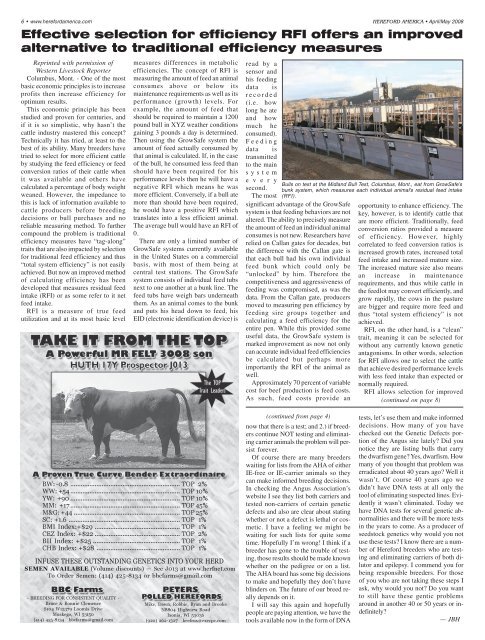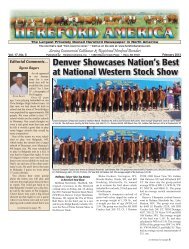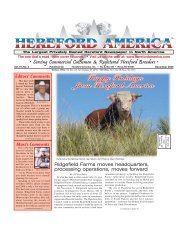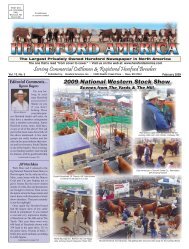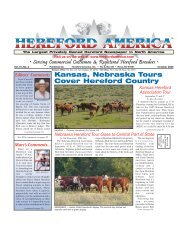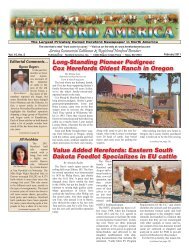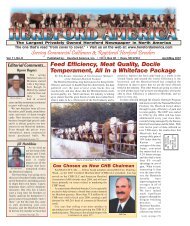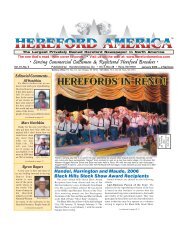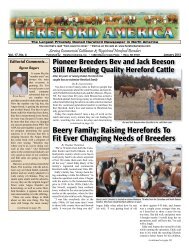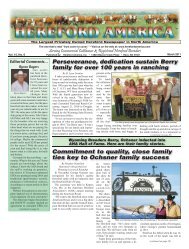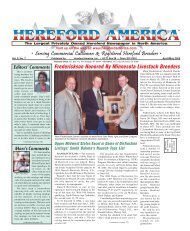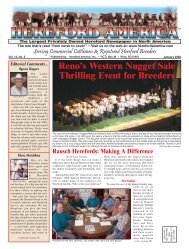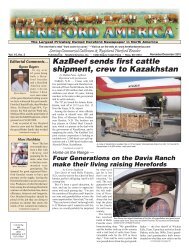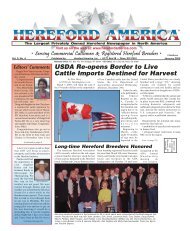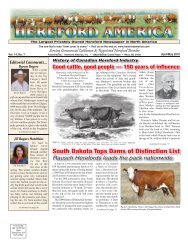April/May 2008 Issue (pdf - 7794 kb)... - Hereford America
April/May 2008 Issue (pdf - 7794 kb)... - Hereford America
April/May 2008 Issue (pdf - 7794 kb)... - Hereford America
You also want an ePaper? Increase the reach of your titles
YUMPU automatically turns print PDFs into web optimized ePapers that Google loves.
6 • www.herefordamerica.com HEREFORD AMERICA • <strong>April</strong>/<strong>May</strong> <strong>2008</strong><br />
Effective selection for efficiency RFI offers an improved<br />
alternative to traditional efficiency measures<br />
Reprinted with permission of<br />
Western Livestock Reporter<br />
Columbus, Mont. - One of the most<br />
basic economic principles is to increase<br />
profits then increase efficiency for<br />
optimum results.<br />
This economic principle has been<br />
studied and proven for centuries, and<br />
if it is so simplistic, why hasn’t the<br />
cattle industry mastered this concept?<br />
Technically it has tried, at least to the<br />
best of its ability. Many breeders have<br />
tried to select for more efficient cattle<br />
by studying the feed efficiency or feed<br />
conversion ratios of their cattle when<br />
it was available and others have<br />
calculated a percentage of body weight<br />
weaned. However, the impedance to<br />
this is lack of information available to<br />
cattle producers before breeding<br />
decisions or bull purchases and no<br />
reliable measuring method. To further<br />
compound the problem is traditional<br />
efficiency measures have “tag-along”<br />
traits that are also impacted by selection<br />
for traditional feed efficiency and thus<br />
“total system efficiency” is not easily<br />
achieved. But now an improved method<br />
of calculating efficiency has been<br />
developed that measures residual feed<br />
intake (RFI) or as some refer to it net<br />
feed intake.<br />
RFI is a measure of true feed<br />
utilization and at its most basic level<br />
measures differences in metabolic<br />
efficiencies. The concept of RFI is<br />
measuring the amount of feed an animal<br />
consumes above or below its<br />
maintenance requirements as well as its<br />
performance (growth) levels. For<br />
example, the amount of feed that<br />
should be required to maintain a 1200<br />
pound bull in XYZ weather conditions<br />
gaining 3 pounds a day is determined.<br />
Then using the GrowSafe system the<br />
amount of feed actually consumed by<br />
that animal is calculated. If, in the case<br />
of the bull, he consumed less feed than<br />
should have been required for his<br />
performance levels then he will have a<br />
negative RFI which means he was<br />
more efficient. Conversely, if a bull ate<br />
more than should have been required,<br />
he would have a positive RFI which<br />
translates into a less efficient animal.<br />
The average bull would have an RFI of<br />
0.<br />
There are only a limited number of<br />
GrowSafe systems currently available<br />
in the United States on a commercial<br />
basis, with most of them being at<br />
central test stations. The GrowSafe<br />
system consists of individual feed tubs<br />
next to one another at a bunk line. The<br />
feed tubs have weigh bars underneath<br />
them. As an animal comes to the bunk<br />
and puts his head down to feed, his<br />
EID (electronic identification device) is<br />
read by a<br />
sensor and<br />
his feeding<br />
data is<br />
recorded<br />
(i.e. how<br />
long he ate<br />
and how<br />
much he<br />
consumed).<br />
Feeding<br />
data is<br />
transmitted<br />
to the main<br />
system<br />
e v e r y<br />
second.<br />
The most<br />
Bulls on test at the Midland Bull Test, Columbus, Mont., eat from GrowSafe’s<br />
bunk system, which measures each individual animal’s residual feed intake<br />
(RFI).<br />
significant advantage of the GrowSafe opportunity to enhance efficiency. The<br />
system is that feeding behaviors are not key, however, is to identify cattle that<br />
altered. The ability to precisely measure are more efficient. Traditionally, feed<br />
the amount of feed an individual animal conversion ratios provided a measure<br />
consumes is not new. Researchers have of efficiency. However, highly<br />
relied on Callan gates for decades, but correlated to feed conversion ratios is<br />
the difference with the Callan gate is increased growth rates, increased total<br />
that each bull had his own individual feed intake and increased mature size.<br />
feed bunk which could only be The increased mature size also means<br />
“unlocked” by him. Therefore the an increase in maintenance<br />
competitiveness and aggressiveness of requirements, and thus while cattle in<br />
feeding was compromised, as was the the feedlot may convert efficiently, and<br />
data. From the Callan gate, producers grow rapidly, the cows in the pasture<br />
moved to measuring pen efficiency by are bigger and require more feed and<br />
feeding sire groups together and thus “total system efficiency” is not<br />
calculating a feed efficiency for the achieved.<br />
entire pen. While this provided some RFI, on the other hand, is a “clean”<br />
useful data, the GrowSafe system is trait, meaning it can be selected for<br />
marked improvement as now not only without any currently known genetic<br />
can accurate individual feed efficiencies antagonisms. In other words, selection<br />
be calculated but perhaps more for RFI allows one to select the cattle<br />
importantly the RFI of the animal as that achieve desired performance levels<br />
well.<br />
with less feed intake than expected or<br />
Approximately 70 percent of variable normally required.<br />
cost for beef production is feed costs. RFI allows selection for improved<br />
As such, feed costs provide an (continued on page 8)<br />
BW: -0.8 ............................................................... TOP 2%<br />
WW: +54 ............................................................... TOP 10%<br />
YW: +90 ............................................................... TOP 10%<br />
MM: +17............................................................... TOP 45%<br />
M&G: +44 ............................................................. TOP 25%<br />
SC: +1.6 ................................................................ TOP 1%<br />
BMI Index:+$29 ................................................. TOP 1%<br />
CEZ Index: +$22 ................................................. TOP 2%<br />
BII Index: +$25 .................................................. TOP 1%<br />
CHB Index: +$28 ................................................ TOP 1%<br />
INFUSE THESE OUTSTANDING GENETICS INTO YOUR HERD<br />
SEMEN AVAILABLE (Volume discounts) — See J013 at www.herfnet.com<br />
To Order Semen: (414) 425-8134 or bbcfarms@gmail.com<br />
- BREEDING FOR CONSISTENT QUALITY -<br />
Bruce & Bonnie Clemence<br />
S104 W15379 Loomis Drive<br />
Muskego, WI 53150<br />
(414) 425-8134 bbcfarms@gmail.com<br />
Mike, Dawn, Robbie, Ryan and Brooke<br />
N8804 Highview Road<br />
Ixonia, WI 53036<br />
(920) 262-1507 beefrus@execpc.com<br />
(continued from page 4)<br />
now that there is a test; and 2.) if breeders<br />
continue NOT testing and eliminating<br />
carrier animals the problem will persist<br />
forever.<br />
Of course there are many breeders<br />
waiting for lists from the AHA of either<br />
IE-free or IE-carrier animals so they<br />
can make informed breeding decisions.<br />
In checking the Angus Association’s<br />
website I see they list both carriers and<br />
tested non-carriers of certain genetic<br />
defects and also are clear about stating<br />
whether or not a defect is lethal or cosmetic.<br />
I have a feeling we might be<br />
waiting for such lists for quite some<br />
time. Hopefully I’m wrong! I think if a<br />
breeder has gone to the trouble of testing,<br />
those results should be made known<br />
whether on the pedigree or on a list.<br />
The AHA board has some big decisions<br />
to make and hopefully they don’t have<br />
blinders on. The future of our breed really<br />
depends on it.<br />
I will say this again and hopefully<br />
people are paying attention, we have the<br />
tools available now in the form of DNA<br />
tests, let’s use them and make informed<br />
decisions. How many of you have<br />
checked out the Genetic Defects portion<br />
of the Angus site lately? Did you<br />
notice they are listing bulls that carry<br />
the dwarfism gene? Yes, dwarfism. How<br />
many of you thought that problem was<br />
erradicated about 40 years ago? Well it<br />
wasn’t. Of course 40 years ago we<br />
didn’t have DNA tests at all only the<br />
tool of eliminating suspected lines. Evidently<br />
it wasn’t eliminated. Today we<br />
have DNA tests for several genetic abnormalities<br />
and there will be more tests<br />
in the years to come. As a producer of<br />
seedstock genetics why would you not<br />
use these tests? I know there are a number<br />
of <strong>Hereford</strong> breeders who are testing<br />
and eliminating carriers of both dilutor<br />
and epilepsy. I commend you for<br />
being responsible breeders. For those<br />
of you who are not taking these steps I<br />
ask, why would you not? Do you want<br />
to still have these gentic problems<br />
around in another 40 or 50 years or indefinitely?<br />
— JBH


